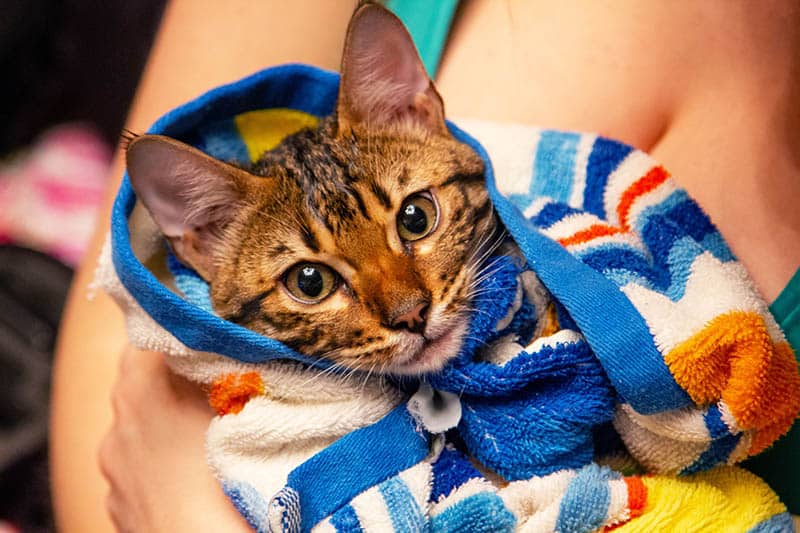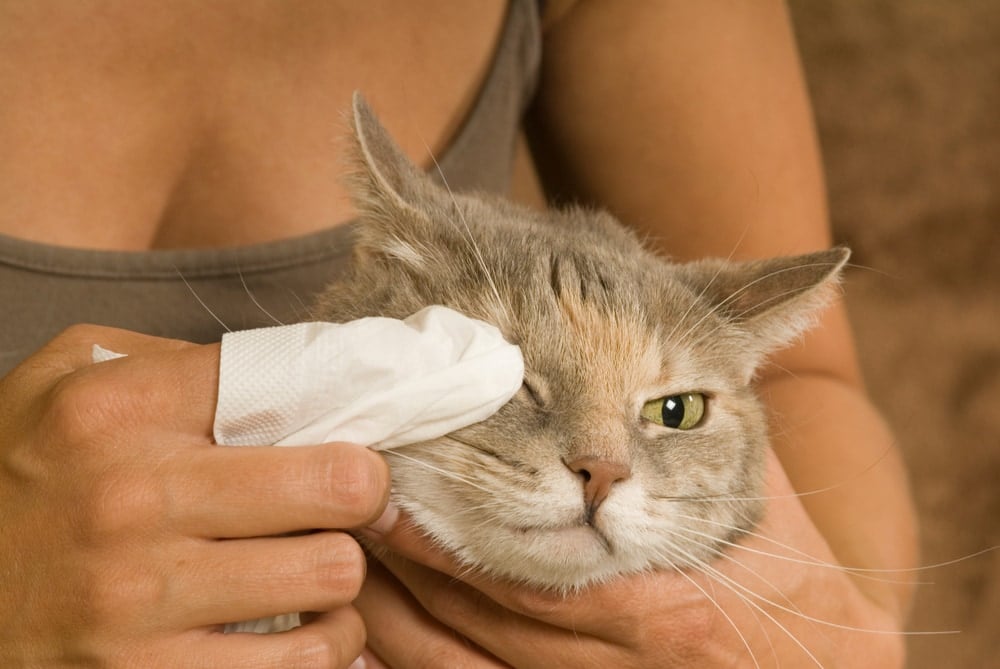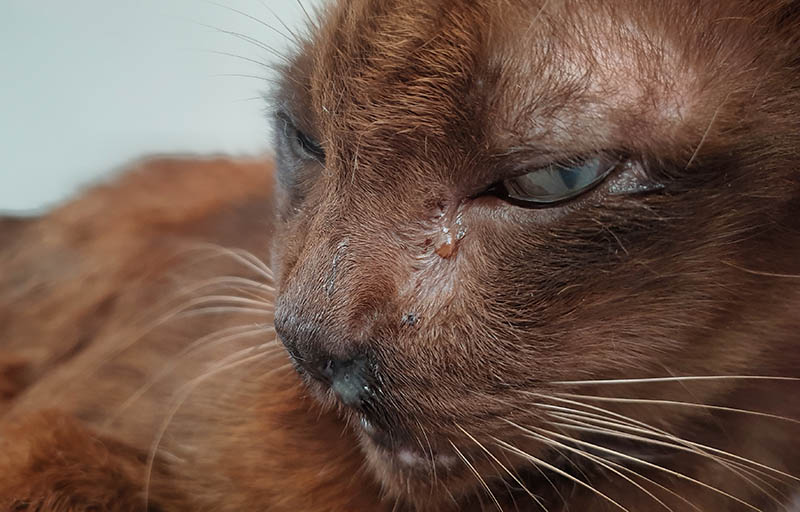A thin layer of tears protects a cat’s eyeball, protecting the eye from any irritants or foreign bodies to keep vision clear. The overflow of tears can cause discharge or “eye boogers,” which come from the overproduction of tears or blocked tear drainage.
Cleaning out your cat’s eye boogers helps keep the eye clear and removes any irritants. Mild discharge can be expected in cats, but excessive discharge may indicate an underlying health issue.
Before You Start – Rule Out Infection
Small amounts of eye boogers are a normal eye response, but it shouldn’t be a recurring issue that impacts the well-being of your cat. Excessive eye discharge is a common symptom of various diseases and infections.
If you suspect an infection, then get your vet’s advice before attempting to clean your cat’s eyes.
- Rubbing of the eyes
- Redness
- Swelling
- Squinting
- Vision impairment
- Nasal congestion
- Sneezing or coughing
- Difficulty breathing
How to Clean Cat Eye Boogers
1. Gather All Equipment
This is arguably the most critical step. Before you grab your cat and start prodding around the eyes, make sure you have everything you are going to need.
Most cats actively dislike being held forcefully, especially if you are doing something so invading as rubbing their eyes. If you need to go and grab some more materials, your cat will take the opportunity to get out of there, and good luck catching them again!
- Clean water or saline solution (ask your veterinarian for suggestions)
- A clean cloth or cotton balls
- A clean, dry cloth for drying
- A towel for restraint (optional)
- A helping hand (optional)
2. Restrain Your Cat
Nine out of ten cats will not enjoy their eyes being bothered. If you have a calm cat, you might find that you need to do very little to restrain them besides position them on your lap.
For the rest of you, it’s essential to restrain or subdue your cat long enough to do the cleaning. If they wriggle too much, you risk hurting their eyes or getting injured yourself.
Our best recommendation is to get someone to help you by firmly wrapping your cat in a towel, the classic “purr-ito” cat. This gentle restraint means your cat can’t get any paws out to swipe at you and gives the handler complete control.
Your cat won’t like it initially, but overall, it will reduce stress as the cleaning process can be over in the blink of an eye with a restrained cat.

3. Wipe Gently
The actual cleaning of the eye is done with either a clean washcloth or cotton balls. Dip either one into warm clean water or saline solution to dampen it, then gently wipe the eye starting at the inner corner and wiping downwards and out.
Avoid applying too much pressure as it will cause discomfort.
It should lift easily from the eyes for soft discharge, but dry, hard boogers can take some effort. Hold the cloth on the discharge for a few seconds to let the moisture moisten it and help to lift it from the skin.
For stubborn discharge lodged in the corners of the eye, that can’t be removed as mentioned above, consult with your veterinarian. This will avoid you causing any damage to the eye(s).
Cleaning your cat's sensitive areas can be tricky, but high-quality wet wipes can make it much easier. Try a natural, hypoallergenic option like Hepper's Wash Wipes, made with moisturizing ingredients and specifically designed to gently clean your cat's skin and fur. These wipes are as convenient as they are effective! At Catster, we’ve admired Hepper for many years and decided to take a controlling ownership interest so that we could benefit from the outstanding designs of this cool cat company!
Are Cat Eye Boogers Normal?
Mild eye boogers are standard and not usually a cause for concern. Slight discharge occurs when the eye is irritated, but often it comes from mild allergens in the air, such as dust. It usually isn’t due to an underlying issue with the eye.
Constant eye boogers or severe discharge may tell a different story. This kind of discharge, coupled with other symptoms, should be seen by a vet. Potential illness or injury left untreated may cause permanent damage to the eye.

Causes of Excessive Cat Eye Discharge
- Particular breeds such as Persians or Himalayans
- Allergies
- Foreign object in the eye
- Corneal ulcer
- Conjunctivitis
- Blocked tear ducts
- Respiratory infection
Final Thoughts
A cat’s eye boogers can be a bit unpleasant, especially when your cat loves to rub their face up against you. To help keep their face clean and eyes healthy, you can gently wipe away discharge using warm water or saline solutions recommended by your veterinarian.
However, knowing the causes of excessive eye discharge and the symptoms is essential to identify when something is not quite right.
Related Read:
- Tips on How to Use Cat Eye Drops (Without Getting Scratched)
- How to Keep Your Cat’s Eyes Healthy: Vet-Approved Guide
Featured Image Credit: RJ22, Shutterstock















